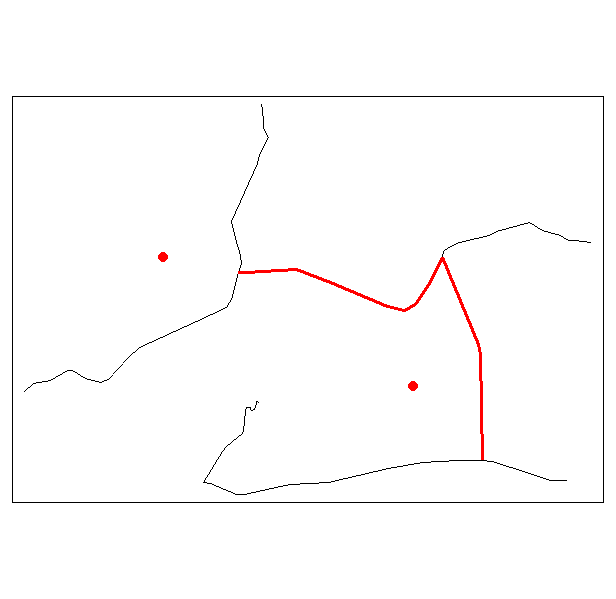Friends could help me resolve the following issue:
I am inserting two executable codes below, the first generates a map, showing the route between two locations. In this case, the two locations to generate the map were defined: from = c(df_spec_clust[1, c("Longitude")], df_spec_clust[1, c("Latitude")])
and to = c (df_spec_prop [4, c ("Longitude")], df_spec_prop [4, c ("Latitude")])]. In the second, I would like to generate the map in Shiny format, but without defining the locations exactly as I did in the first code. I would like them to be selected from the filters I created (Filter 1 and Filter 2). However, I am unable to generate the map. Could you help me ?
First code
library(sf)
library(sfnetworks)
library(tmap)
library(rdist)
library(geosphere)
#database df
df <- structure(
list(Property = c(1,2,3,4,5,6,7), Latitude = c(-24.779225, -24.789635, -24.763461, -24.794394, -24.747102,-24.781307,-24.761081),
Longitude = c(-49.934816, -49.922324, -49.911616, -49.906262, -49.890796,-49.8875254,-49.8875254),
Waste = c(526, 350, 526, 469, 285, 433, 456)),class = "data.frame", row.names = c(NA, -7L))
#clusters
coordinates<-df[c("Latitude","Longitude")]
d<-as.dist(distm(coordinates[,2:1]))
fit.average<-hclust(d,method="average")
k=3
clusters<-cutree(fit.average, k)
nclusters<-matrix(table(clusters))
df$cluster <- clusters
#Create database df1
center<-matrix(nrow=k,ncol=2)
for(i in 1:k){
center[i,]<-c(weighted.mean(subset(df,cluster==i)$Latitude,subset(df,cluster==i)$Waste),
weighted.mean(subset(df,cluster==i)$Longitude,subset(df,cluster==i)$Waste))}
coordinates$cluster<-clusters
center<-cbind(center,matrix(c(1:k),ncol=1))
df1<-as.data.frame(center)
colnames(df1) <-c("Latitude", "Longitude", "cluster")
#specific cluster and specific property
df_spec_clust <- df1[df1$cluster,]
df_spec_prop<-df[df$Property,]
#create map
download.file("https://github.com/JovaniSouza/JovaniSouza5/raw/master/Test.zip", "Test.zip")
unzip("Test.zip")
roads = st_read("Test/regionbrazil.shp", quiet = TRUE) %>%
st_cast("LINESTRING")
# build sfnetwork
net = as_sfnetwork(roads, directed = FALSE) %>%
activate("edges") %>%
dplyr::mutate(weight = edge_length())
# routing
from = c(df_spec_clust[1, c("Longitude")], df_spec_clust[1, c("Latitude")])
to = c(df_spec_prop[4, c("Longitude")], df_spec_prop[4, c("Latitude")])
p1 = st_as_sf(data.frame(x = from[1], y = from[2]), coords = c("x", "y"), crs = st_crs(net))
p2 = st_as_sf(data.frame(x = to[1], y = to[2]), coords = c("x", "y"), crs = st_crs(net))
r = tidygraph::convert(net, to_spatial_shortest_paths, p1, p2)
# Extract the bbox for r
bbox_r = st_as_sfc(r %>% activate(edges) %>% st_bbox())
# filter the net
small_net = st_filter(net, bbox_r)
# plot
plot1<-tm_shape(small_net %>% activate(edges) %>% st_as_sf()) +
tm_lines() +
tm_shape(rbind(p1, p2)) +
tm_dots(col = "red", size = 0.5) +
tm_shape(r %>% activate(edges) %>% st_as_sf()) +
tm_lines(col = "red", lwd = 3)
plot1
Map generated by the code above
Second code
library(shiny)
library(rdist)
library(geosphere)
library(shinythemes)
library(sf)
library(tidygraph)
library(sfnetworks)
library(tmap)
#for the roads file
download.file("https://github.com/JovaniSouza/JovaniSouza5/raw/master/Test.zip", "Test.zip")
unzip("Test.zip")
function.cl<-function(df,k,Filter1,Filter2){
#database df
df <- structure(
list(Property = c(1,2,3,4,5,6,7), Latitude = c(-24.779225, -24.789635, -24.763461, -24.794394, -24.747102,-24.781307,-24.761081),
Longitude = c(-49.934816, -49.922324, -49.911616, -49.906262, -49.890796,-49.8875254,-49.8875254),
Waste = c(526, 350, 526, 469, 285, 433, 456)),class = "data.frame", row.names = c(NA, -7L))
#clusters
coordinates<-df[c("Latitude","Longitude")]
d<-as.dist(distm(coordinates[,2:1]))
fit.average<-hclust(d,method="average")
clusters<-cutree(fit.average, k)
nclusters<-matrix(table(clusters))
df$cluster <- clusters
#Create database df1
center<-matrix(nrow=k,ncol=2)
for(i in 1:k){
center[i,]<-c(weighted.mean(subset(df,cluster==i)$Latitude,subset(df,cluster==i)$Waste),
weighted.mean(subset(df,cluster==i)$Longitude,subset(df,cluster==i)$Waste))}
coordinates$cluster<-clusters
center<-cbind(center,matrix(c(1:k),ncol=1))
df1<-as.data.frame(center)
colnames(df1) <-c("Latitude", "Longitude", "cluster")
# specific cluster and specific property
df_spec_clust <- df1[df1$cluster==Filter1,]
df_spec_prop<-df[df$Property==Filter2,]
#create map
roads = st_read("Test/regionbrazil.shp", quiet = TRUE) %>%
st_cast("LINESTRING")
# build sfnetwork
net = as_sfnetwork(roads, directed = FALSE) %>%
activate("edges") %>%
dplyr::mutate(weight = edge_length())
# routing
from = c(df_spec_clust[1, c("Longitude")], df_spec_clust[1, c("Latitude")])
to = c(df_spec_prop[4, c("Longitude")], df_spec_prop[4, c("Latitude")])
p1 = st_as_sf(data.frame(x = from[1], y = from[2]), coords = c("x", "y"), crs = st_crs(net))
p2 = st_as_sf(data.frame(x = to[1], y = to[2]), coords = c("x", "y"), crs = st_crs(net))
r = tidygraph::convert(net, to_spatial_shortest_paths, p1, p2)
# Extract the bbox for r
bbox_r = st_as_sfc(r %>% activate(edges) %>% st_bbox())
# filter the net
small_net = st_filter(net, bbox_r)
# plot
plot1<-tm_shape(small_net %>% activate(edges) %>% st_as_sf()) +
tm_lines() +
tm_shape(rbind(p1, p2)) +
tm_dots(col = "red", size = 0.5) +
tm_shape(r %>% activate(edges) %>% st_as_sf()) +
tm_lines(col = "red", lwd = 3)
return(list(
"Plot1" = plot1,
"Data" = df
))
}
ui <- bootstrapPage(
navbarPage(theme = shinytheme("flatly"), collapsible = TRUE,
"Cl",
tabPanel("",
sidebarLayout(
sidebarPanel(
sliderInput("Slider", h5(""),
min = 2, max = 4, value = 3),
selectInput("Filter1", label = h4("Select just one cluster"),""),
selectInput("Filter2",label=h4("Select the cluster property"),""),
),
mainPanel(
tabsetPanel(
tabPanel("Map", plotOutput("Map1"))))
))))
server <- function(input, output, session) {
Modelcl<-reactive({
function.cl(df,input$Slider,input$Filter1,input$Filter2)
})
output$Map1 <- renderPlot({
Modelcl()[[1]]
})
observeEvent(input$Slider, {
abc <- req(Modelcl()$Data)
updateSelectInput(session,'Filter1',
choices=sort(unique(abc$cluster)))
})
observeEvent(input$Filter1,{
abc <- req(Modelcl()$Data) %>% filter(cluster == as.numeric(input$Filter1))
updateSelectInput(session,'Filter2',
choices=sort(unique(abc$Property)))
})
}
shinyApp(ui = ui, server = server)
For test: Map using leaflet package (It works)
library(shiny)
library(rdist)
library(geosphere)
library(shinythemes)
library(leaflet)
library(tidygraph)
function.cl<-function(df,k,Filter1,Filter2){
#database df
df <- structure(
list(Property = c(1,2,3,4,5,6,7), Latitude = c(-24.779225, -24.789635, -24.763461, -24.794394, -24.747102,-24.781307,-24.761081),
Longitude = c(-49.934816, -49.922324, -49.911616, -49.906262, -49.890796,-49.8875254,-49.8875254),
Waste = c(526, 350, 526, 469, 285, 433, 456)),class = "data.frame", row.names = c(NA, -7L))
#clusters
coordinates<-df[c("Latitude","Longitude")]
d<-as.dist(distm(coordinates[,2:1]))
fit.average<-hclust(d,method="average")
clusters<-cutree(fit.average, k)
nclusters<-matrix(table(clusters))
df$cluster <- clusters
#Create database df1
center<-matrix(nrow=k,ncol=2)
for(i in 1:k){
center[i,]<-c(weighted.mean(subset(df,cluster==i)$Latitude,subset(df,cluster==i)$Waste),
weighted.mean(subset(df,cluster==i)$Longitude,subset(df,cluster==i)$Waste))}
coordinates$cluster<-clusters
center<-cbind(center,matrix(c(1:k),ncol=1))
df1<-as.data.frame(center)
colnames(df1) <-c("Latitude", "Longitude", "cluster")
#specify cluster and specific cluster and specific propertie
df_spec_clust <- df1[df1$cluster==Filter1,]
df_spec_prop<-df[df$Property==Filter2,]
#color for map
ai_colors <-c("red","gray","blue","orange","green","beige","darkgreen","lightgreen", "lightred", "darkblue","lightblue",
"purple","darkpurple","pink", "cadetblue","white","darkred", "lightgray","black")
clust_colors <- ai_colors[df$cluster]
icons <- awesomeIcons(
icon = 'ios-close',
iconColor = 'black',
library = 'ion',
markerColor = clust_colors)
# create icon for map
leafIcons <- icons(
iconUrl = ifelse(df1$cluster,
"https://image.flaticon.com/icons/svg/542/542461.svg"
),
iconWidth = 30, iconHeight = 40,
iconAnchorX = 25, iconAnchorY = 12)
html_legend <- "<img src='https://image.flaticon.com/icons/svg/542/542461.svg'>"
# create map
if(nrow(df_spec_clust)>0){
clust_colors <- ai_colors[df_spec_clust$cluster]
icons <- awesomeIcons(
icon = 'ios-close',
iconColor = 'black',
library = 'ion',
markerColor = clust_colors)
m1<-leaflet(df_spec_clust) %>% addTiles() %>%
addMarkers(~Longitude, ~Latitude, icon = leafIcons) %>%
addAwesomeMarkers(leaflet(df_spec_prop) %>% addTiles(), lat=~df_spec_prop$Latitude, lng = ~df_spec_prop$Longitude, icon= icons,label=~cluster)
for(i in 1:nrow(df_spec_clust)){
df_line <- rbind(df_spec_prop[,c("Latitude","Longitude")],
df_spec_clust[i,c("Latitude","Longitude")])
m1 <- m1 %>%
addPolylines(data = df_line,
lat=~Latitude,
lng = ~Longitude,
color="red")
}
plot1<-m1} else plot1 <- NULL
return(list(
"Plot1" = plot1,
"Data"= df
))
}
ui <- bootstrapPage(
navbarPage(theme = shinytheme("flatly"), collapsible = TRUE,
"Cl",
tabPanel("",
sidebarLayout(
sidebarPanel(
sliderInput("Slider", h5(""),
min = 2, max = 4, value = 3),
selectInput("Filter1", label = h4("Select just one cluster"),""),
selectInput("Filter2",label=h4("Select the cluster property"),""),
),
mainPanel(
tabsetPanel(
tabPanel("Map", uiOutput("Map1"))))
))))
server <- function(input, output, session) {
Modelcl<-reactive({
function.cl(df,input$Slider,input$Filter1,input$Filter2)
})
output$Map1 <- renderUI({
if(input$Filter1!="")
leafletOutput("Leaf1",width = "95%", height = "600") })
output$Leaf1 <- renderLeaflet({
req(Modelcl())[[1]]
})
observeEvent(input$Slider, {
abc <- req(Modelcl()$Data)
updateSelectInput(session,'Filter1',
choices=sort(unique(abc$cluster)))
})
observeEvent(input$Filter1,{
abc <- req(Modelcl()$Data) %>% filter(cluster == as.numeric(input$Filter1))
updateSelectInput(session,'Filter2',
choices=sort(unique(abc$Property)))
})
}
shinyApp(ui = ui, server = server)
